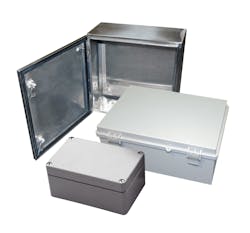Enclosures tend to be an industrial automation afterthought. Everyone knows how critically important they are, but they rarely receive their due in the automation spotlight—particularly when compared to controllers, sensors, and HMI/SCADA hardware and software. Despite this, automation end users have questions and concerns about their use of enclosures, which led one Automation World reader to ask: What’s the difference between standard and certified enclosures?
To get an in-depth explanation for our readers, we connected with Josiah Haas, president of Bud Industries, a manufacturer and supplier of electronics enclosures, for an episode of our Automation World Gets Your Questions Answered Podcast.
Before delving into the details of standard and certified enclosures, Haas informed us about two factors that are changing the face of industrial automation enclosure use.
The first of these factors is how the use of enclosures as large, central control cabinets is no longer the predominant use of the product. “Enclosures are now spreading throughout the plant,” he said. They’re increasingly being used to house equipment that tracks specific portions of the process, such as the number of cycles, error tracking, decision making, maintenance, and reporting.
Haas noted the other factor impacting enclosure use is, what he refers to as, the next generation of enclosure customers. These customers are taking enclosures into lower tech markets that they’re updating with wireless, Bluetooth, tracking, and data monitoring technologies. “We’re seeing more sealed enclosures being used in traffic applications and even apple orchards to track insects,” he said.
Getting back to the reader question about the difference between standard and certified enclosures, Haas focused on the requirements of the application. “Enclosures should be certified if they will be used to contain any kind of automation, electrical or electronic equipment, or any moving parts like fans or motors that could create safety concerns,” he said. “But [the need for certification] also depends on the environment in which they’re being used in. For example, an office setting might not need a certification, but use outside or in a non-cleanroom environment will probably require a certification.”
Haas said that the most requested type of certification for enclosures is through the National Electrical Manufacturers Association (NEMA). “They use a rating system that defines the type of environment and the kind of enclosure that can be used to withstand those elements,” Haas said. “For example, NEMA 4X covers falling dirt, snow, sleet, dust, or water in indoor and outdoor applications. The X means it is corrosion resistant. Ratings like NEMA 1, 2, 3R, 4, 6, 6P, 12, and 13 provide different levels of protection, with NEMA 1 being just an enclosed box, to NEMA 6 or 6P covering submersion in water to NEMA 13, which addresses protection form oil and coolants.”
Another standard rating system for enclosures is the International Electrotechnical Commission’s (IEC) IP rating, which refers to ingress protection. These ratings have a two-digit numbering system and can align with NEMA ratings. “The first digit reflects how protected it is against solids and the second digit shows its protection against liquids,” said Haas. He explained that IP65, while not being exactly the same as NEMA 4, does align with it in that they both require the enclosure to protect from dust and from sprayed water sprayed.
“Then there’s the certifying bodies like United Laboratories in the U.S. (UL), CSA in Canada, and TÜV in Europe,” Haas said. “These [certification] labels show that an independent organization has tested the box and certified that it meets minimum requirements for the rated level of protection.”
Haas explained that certifications play a role not just for end users, but OEMs as well. “For OEMs looking to have their product be UL rated, it helps to have a UL-rated enclosure,” he said. “This limits costs and the time it takes to have the product approved. Enclosure providers should be able to provide OEMs with UL file info.”
To hear this podcast episode, visit the “Automation World Gets Your Questions Answered” podcast site. Our podcasts are also accessible on iTunes, Spotify, and other major podcast platforms. To find them, search for “Automation World Gets Your Questions Answered” and be sure to subscribe to be notified when new episodes are posted.
Leaders relevant to this article:


